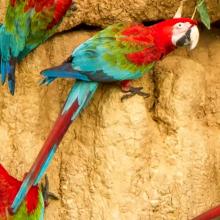Ara chloropterus

Conservation Status:
Least Concern (though still protected by CITES and other international treaties)
Range:
Central and South America
Habitat:
Broad range of habitats. Humid, lowland forest, including tropical forests, mangrove swamps, riparian woodlands, and savannas.
Green-winged macaws have large beaks capable of applying up to 1,000 pounds per square inch of force. Both the upper and lower beak can open separately, and they possess attached muscles that provide additional biting force. The beak is composed of bone with a thin layer of keratin on top, providing the necessary rigidity to withstand such force without breaking. While the upper layers of keratin may occasionally crack, they are replaced by fresh keratin from lower layers. Green-winged macaws feed on nuts, fruits, berries, and leaves, and they can supplement their mineral and sodium intake by consuming clay.
They possess four toes on each foot arranged with two forward and two backward. This foot structure, known as "zygodactyl," is more suitable for climbing on branches compared to the three forward, one backward arrangement found in many other bird species. Additionally, macaws can use their feet to hold fruit and nuts while eating. As messy eaters, macaws play an important role in seed dispersal, as fruit and nut trees often grow from the dropped leftover food of a macaw flock.
Sexual maturity is typically reached around 3 to 4 years of age. Green-winged macaws are monogamous and mate for life. They construct nests in tree hollows positioned as high as possible to avoid predators. The female lays 2 to 4 eggs per clutch, and incubation, lasting approximately 25 days, is solely performed by the female. Juveniles remain with both parents for around 3 months, during which time they learn how to feed and fly.
They travel in large flocks, moving between foraging spots and following the seasonal abundance of various fruits and nuts. Green-winged macaws are capable of flying at speeds of up to 55 km/h! Like all macaws, they have a bare patch of skin on their face, which serves to exchange heat with the environment.
Green-winged macaws have a maximum lifespan of 80 to 100 years.
